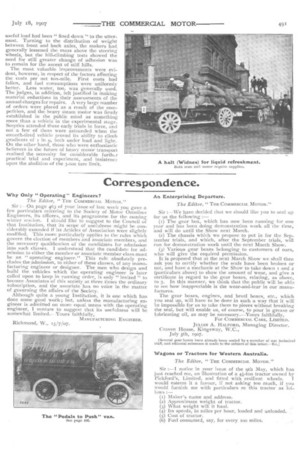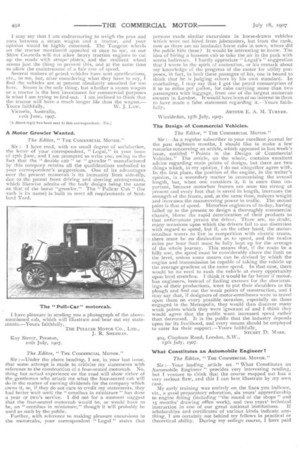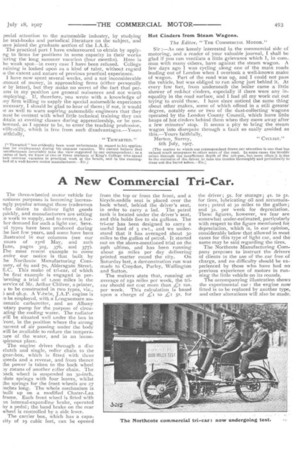Correspondence.
Page 21

Page 22

Page 23

If you've noticed an error in this article please click here to report it so we can fix it.
Why Only " Operating " Engineers?
The Editor, " THE COMMERCIAL MOTOR."
Sir :—On page 463 of your issue of last week you gave a few particulars referring to the Society of Motor Omnibus Engineers, its officers, and its programme for the coming winter session. I should like to suggest to the Council of that Institution, that its scope of usefulness might be considerably extended if its Articles of Association were slightly modified. This more particularly applies to the rules which govern the election of members and associate members, and the necessary qualification of the candidates for admission into such classes. I understand that the candidate for admission to either the member or associate member class must he an " operating engineer." This rule absolutely precludes the admission, to either of these classes, of any manufacturing engineer or designer. The men who design and build the vehicles which the operating engineer is later called upon to keep in running order, is only " invited " to become Associates of this society at three times the ordinary subscription, and the associate has no voice in the matter of governing the affairs of the Society. Although quite a young Institution, it is one which has done some good work; but, unless the manufacturing engineer is admitted on more equal terms with the operating engineer, I venture to suggest that its usefulness will be somewhat limited.— Yours faithfully, MANUFACTURING ENGINEER. Richmond, W., 13/7/07. An Enterprising Departure.
The Editor," THE COMMERCIAL MOTOR."
Sir :—We have decided that we should like you to seal up for us the following :—
(r) The gear box, which has now been running for one year and has been doing demonstration work all the time and will do until the Show next March.
(2) The chassis which we propose to put in for the September trials, and which, after the September trials, will run for demonstration work until the next March Show.
(3) Various gear boxes belonging to customers of ours, who will give the required permission.
It is proposed that at the next March Show we shall then ask you to certify whether the seals have been broken or not, and have a mechanic at the Show to take down i and 2 (particulars above) to show the amount of wear, and give a certificate in regard to the gear boxes, relating, as above, to 3. In this manner, we think that the public will be able to see how inappreciable is the wear-and-tear in our manufactures.
The gear boxes, engines, and bevel boxes, etc., which you seal up, will have to be done in sttch a way that it will be impossible for us to take them to pieces without breaking the seal, but will enable us, of course, to pour in grease or lubricating oil, as may be necessary.—Yours faithfully, For COMMERCIAL CARS, LIMITED.
JULIAN A. H ALFORD, Managing Director. Craven House, King-sway, W.C., July sth, 1907. .
[Several gear boxes have already been sealed by a member of our technical staff, and editorial reference is made to the subject of this letter.—ED.]
Wagons or Tractors for Western Australia.
The Editor, "THE COMMERCIAL MOTOR."
Sir :—I notice in your issue of the 9th May, which has just reached me, an illustration of a 4-ton tractor owned by Pickford's, Limited, and fitted with resilient wheels. I would esteem it a favour, if not asking too much, if you would furnish me with particulars re this tractor as follows :— (t) Maker's name and address.
(2) Approximate weight of tractor. (3) What weight will it haul. (4) Its speeds, in miles per hour, loaded and unloaded..
(s) Cost of tractor. (6) Fuel consumed, say, for every too miles. I may say that I am endeavouring to weigh the pros and cons between a steam wagon and a tractor, and your opinion would be highly esteemed. The Tangent wheels on the tractor mentioned appealed at once to me, as our Shire Councils will not allow heavy traction engines to cut up the roads with strope plates, and the resilient wheel seems just the thing to prevent this, and at the same time to allow the maintenance of a fair rate of speed.
Several makers of petrol vehicles have sent specifications, ete., to me, but, after considering what they have to say, I find the vehicles are at present absolutely unsuited for use here. Steam is the only thing, but whether a steam wagon or a tractor is the best investment for commercial purposes is what I am trying to find but I am inclined to think that the tractor will have a much longer life than the. wagon.— You rs faithfully, W. J. LAW. Victoria, Australia,
rah June, 1907.
(A direk reply hn,s been sent to this correspandent.—En.]
A Motor Growler Wanted.
The Editor, " THE COMMERCIAL MOTOR."
Sir I have read, with no small degree of satisfaction, the letter of your correspondent, " Legal," in your issue of 27th June, and I am prompted to write you, owing to the fact that the " double cab " or" growler " manufactured by this company retains all the qualifications embodied in your correspondent's suggestions. One of its advantages' over the present rnotoreab is its immunity from side-slip, due to the patent front driving and steering arrangement, which likewise admits of the body design being the same as that of the horse "growler." The " Pulkar Cab " (for such is its name) is built to meet all requirements of Scotland Yard.
I have pleasure in sending you a photograph of the above mentioned cab, which will illustrate and bear out my state,ments.—Yours faithfully,
THE PULLCAR MOTOR CO., LID., J. R. SHERMAN.
Kay Street, Preston, roth July, 1907.
The Editor," THE COMMERCIAL MOTOR."
Sir :—Under the .above heading, I see, in your last issue, that some attempt is made to criticise my statements with reference to the construction of a four-seated motorcab. Nothing but actual experience on the road will show either of the gentlemen who attack me what the four-seated cab will do in the matter of earning dividends for the company which owns it, so, if they do not care to credit my statements, they had better wait until the " omnibus in miniature " has done a year or two's service. I did not for a moment suggest that the four-seated motorcab would be, or would have to be, an " omnibus in miniature," though it will probably be used as such by the public.
Further, with reference to making pleasure excursions in the motorcabs, your correspondent " Legal " states that
persons made similar excursions in horse-drawn vehicles which were not hired from jobmasters, but from the rank,. now as there are no landaulet horse cabs in town, where did the public hif-e these? It would be interesting to know. The idea of -hiring a hansom cab to take the air in the park with seems ludicrous. I hardly appreciate " Leg-al's " suggestion that I wrote in the spirit of contention, or his remark about my knowledge of the progress of the motor for utility purposes, in fact, in both these passages of his one is bound to think that he is judging others_ by his own standard. In concluding, I may say that I got the petrol consumption of S to ro miles per gallon, for cabs carrying more than two passengers with luggage, from one of the largest motorcab owners in London. It would have been of no interest to them to have made a false statement regarding it.--Yours faithfully,
ARTHUR E. A. M. TURNER.
Wimbledon, r5th July, 1907.
The Design of Commercial Vehicles.
The Editor, "Tim COMMERCIAL MOTOR."
Sir :—As a regular subscriber to your excellent journal for the past eighteen months, I should like to make a few remarks concerning an article, which appeared in last week's issue, entitled " Points in the Design of Commercial Vehicles." The article, on the whole, contains excellent advice regarding main points of design, but there are two things which, in my opinion, I do not altogether agree with. In the first place, the position of the engine, in the writer's opinion, is a secondary matter in economising. the overall length, but, when one considers it, it is more than important, because motorbus frames are none too strong at present and every foot that is saved in length, increases the strength of the frame, and, at the same time, reduces weight and increases the manceuvring power in traffic. The second point is that of speed. Motorbus engineers of to-day, having failed up to the present to design a thoroughly commercial chassis, blame the rapid deterioration of their products to that unfortunate person_ the driver. There are, no doubt, many occasions upon which the drivers fail to use discretion with regard to speed, but if, on the other hand, the motoromnibus wants to live in competition with electric trams, there must be no diminution as to speed, and the twelve miles per hour limit must be fuliy kept up for the average of the whole journey. This means that, if the route be a hilly one, the speed must be considerably above the limit on the level, unless some means can be devised by which the engine and transmission be capable of taking the vehicle up the average gradient at the same speed. In that case, there would be no need to rush the vehicle at every opportunity upon level stretches. I think it would be far better if motorbus engineers, instead of finding excuses for the shortcom, ings of their productions, were to put their shoulders to the plough and find out the weak points of construction, and I may say that, if designers of motor-omnibuses were to travel upon them on every possible occasion, especially on those engaged in the Metropolis, they would then discover many weak points which they were ignorant of and I think they would agree that the public want increased speed rather than decreased. It is the public that the industry depends upon for its livelihood, and every means should be employed to cater for their support.—Yours faithfully,
STUART D. MARE. 4o4, Clapham Road, London, S.W., isth July, 1907.
What Constitutes an Automobile Engineer?
The Editor, " THE COMMERCIAL MOTOR."
Sir :—Your leading article on " What Constitutes an Automobile Engineer " provides very interesting reading, but I venture to think that the course mapped out has a very serious /law, and this I can best illustrate by my own case.
My early training was entirely on the lines you indicate, viz., a good preparatory education, six years' apprenticeship to engine fitting (including "the round of the shops " and t5 months' drawing office work), and two years' technical
instruction in one of our great national institutions. If scholarships and certificates of various kinds indicate anything, I am certainly not behind my fellows, in practical or theoretical ability. During my college course, I have paid
pedal attention to the automobile industry, by studying he text-books and periodical literature on the subject, and lave joined the graduate section of the I.A.E.
The practical part I have endeavoured to obtain by -applyng to firms for positions in some capacity in their works luring the long summer vacation (four months). Here is he weak spot—in every case I have been refused. College raining is looked upon as a kind of taint, without regard o the extent and nature of previous practical experience. I have now spent several weeks, and a not inconsiderable .mount of money, in approaching firms (either personally
■ tby letter), but they make no secret of the fact that perons in my position are general nuisances and not worth 'mploying. If, therefore, you wrote with a knowledge of .ny firm willing to supply the special automobile experience lecessary, I should be glad to hear of them ; if not, it would le as well to warn aspiring automobile engineers that they Oust be content with what little technical training they can
■ btain at evening classes during apprenticeship, or be conlemned, as I appear to be, to enter the teaching profession, villy-nilly, which is free from such disadvantages.—Yours aithfully,
"THWARTED."
[" Thwarted" has evidently been most unfortunate in regard to his applies.one for employment during his summer vacation. We cannot believe that tanufacturers invariably take the view suggested by our correspondent ; as a tatter of fact, we know of two or three students of King's College who spend aeir summer vacation in practical work at the bench, and in the runningbed of a well-known motor inanufacturer.—En.] Hot Cinders from Steam Wagons.
The Editor, "THE COMMERCIAL MOTOR."
Sir :—As one keenly interested in the commercial side of motoring, and a reader of your valuable journal, I shall be glad if you can ventilate a little grievance which I, in corn-, mon with many others, have against the steam wagon. A few days ago I was cycling along one of the main roads leading out of London when I overtook a well-known make of wagon. Part of the road was up, and I could not pass the vehicle, but was obliged to run along just behind it. At every few feet, from underneath the boiler came a• little shower of red-hot cinders, especially if there were any inequality in the road surface, and I had all my work cut out trying to avoid these. I have since noticed the same thing about other makes, some of which offend in a still greater degree, notably one or two of the dust-collecting wagons operated by the London County Council, which leave little heaps of hot cinders behind them when they move away, after a few minutes' stop. It seems a pity to bring the steam wagon into disrepute through a fault so easily avoided as this.—Yours faithfully,
Merton, Surrey, " CYCLIST." 6th July, 1907.
[The matter to which our correspondent draws our attention is one that has caused much annoyance to other users of the road. In some eases the trouble arises through the insufficient depth of the ash-pan, but more often it is due to the omission of the driver to take the trouble thoroughly and periodically to clear out the burnt ashes.—Em]


























